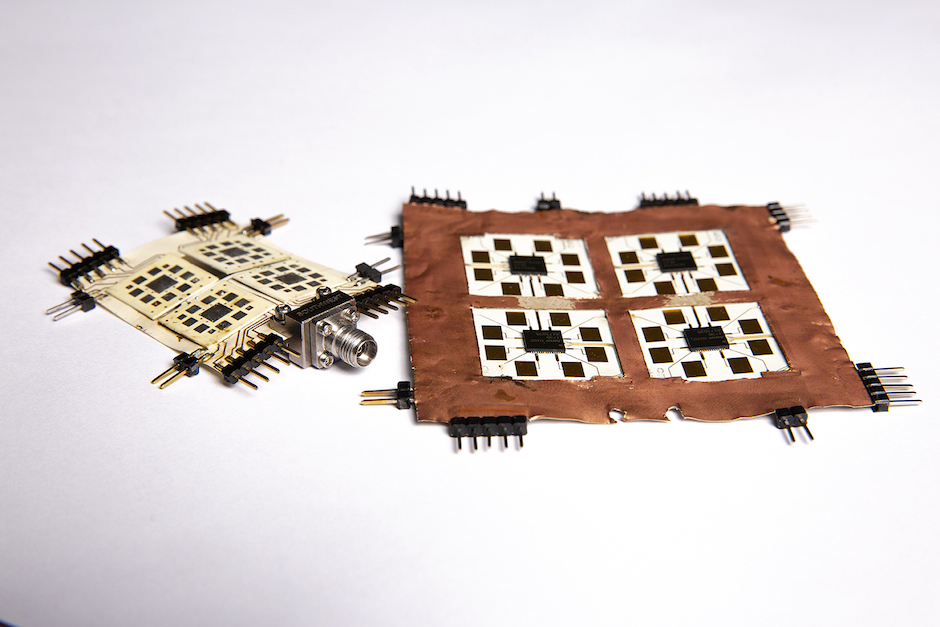
According to research by Gartner, 5G+ (5G/Beyond 5G) is the fastest-growing segment and only significant opportunity for investment growth in the wireless network infrastructure market. Currently 5G+ technologies rely on large antenna arrays, typically bulky and available in limited sizes, making them difficult to transport and expensive to customise.
Now, researchers at Georgia Tech’s College of Engineering claim to have developed a flexible solution for the problem. Their 5G+ enabled smart skins have the potential to enable intelligence on nearly any surface or object, researchers said.
Published in Scientific Reports, their study describes the approach which is said to be not only more scalable and customisable than current practices, but features no performance degradation whenever flexed or scaled to a very large number of tiles.
“Typically, there are a lot of smaller wireless network systems working together, but they are not scalable. With the current techniques, you can’t increase, decrease, or direct bandwidth, especially for very large areas,” said Manos Tentzeris, Ken Byers Professor in Flexible Electronics in the School of Electrical and Computer Engineering. “Being able to utilise and scale this novel tile-based approach makes this possible.”
Tentzeris said his team’s modular application equipped with 5G+ capability has the potential for immediate, large-scale impact as the telecommunications industry continues to rapidly transition to standards for faster, higher capacity and lower latency communications.
The new approach involves assembling additively manufactured tiles onto a single, flexible underlying layer. This allows tile arrays to be attached to a multitude of surfaces. The architecture also allows for very large 5G+ phased/electronically steerable antenna array networks to be installed on-the-fly, the team said.
According to Tentzeris, attaching a tile array to an unmanned aerial vehicle (UAV) is even a possibility to surge broadband capacity in low coverage areas.
Researchers said they fabricated a proof-of-concept, flexible 5x5cm tile array and wrapped it around a 3.5cm radius curvature. Each tile includes an antenna subarray and an integrated, beamforming integrated circuit on an underlying tiling layer to create a smart skin that can seamlessly interconnect the tiles into very large antenna arrays and massive multiple-input multiple-outputs (MIMOs) — the practice of housing two or more antennas within a single wireless device.
Tile-based array architectures on rigid surfaces with single antenna elements have been researched before, but do not include the modularity, additive manufacturability, or flexible implementation of this design, the Georgia Tech team explained.
The proposed modular tile approach means tiles of identical sizes can be manufactured in large quantities and are easily replaceable, reducing the cost of customisation and repairs.
“The shape and features of each tile scale can be singular and can accommodate different frequency bands and power levels,” said Tentzeris. “One could have communications capabilities, another sensing capabilities, and another could be an energy harvester tile for solar, thermal, or ambient RF energy. The application of the tile framework is not limited to communications.”
Internet of Things, virtual reality and smart manufacturing/Industry 4.0 are additional areas of application the team plans to explore. Next steps will involve testing the approach outside the lab on large, real-world structures. The team is currently working on fabrication of larger, fully inkjet-printed tile arrays (256+ elements).
“The tile-architecture’s mass scalability makes its applications particularly diverse and virtually ubiquitous,” said Tentzeris. “From structures the size of dams and buildings, to machinery or cars, down to individual health-monitoring wearables.
“We’re moving in a direction where everything will be covered in some type of a wireless conformal smart skin encompassing electronically steerable antenna arrays of widely diverse sizes that will allow for effective monitoring.”




Glasgow trial explores AR cues for autonomous road safety
They've ploughed into a few vulnerable road users in the past. Making that less likely will make it spectacularly easy to stop the traffic for...